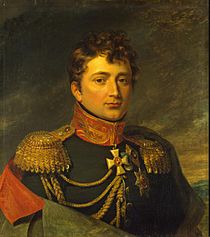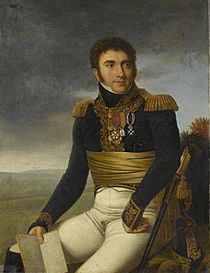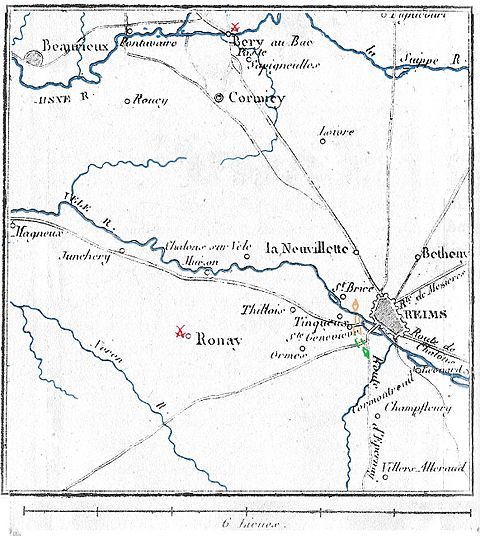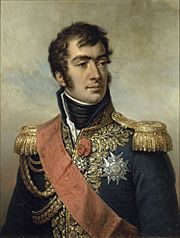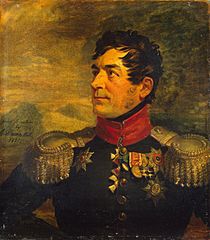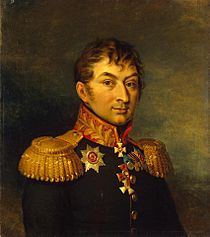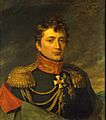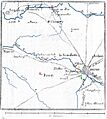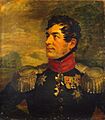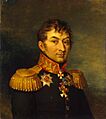Battle of Reims (1814) facts for kids
Quick facts for kids Battle of Reims (1814) |
|||||||
|---|---|---|---|---|---|---|---|
| Part of the Campaign of France of the Sixth Coalition | |||||||
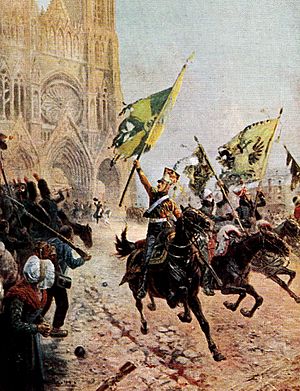 The Last Victory, by Maurice Orange |
|||||||
|
|||||||
| Belligerents | |||||||
| Commanders and leaders | |||||||
| Strength | |||||||
| 13 March: 8,000-10,000 |
13 March: Russia: 7,800-9,000 Prussia: 4,000-5,600 |
||||||
| Casualties and losses | |||||||
| 700 | 6,000-8,000 | ||||||
The Battle of Reims was fought in Reims, France, on March 12–13, 1814. It was a clash between the French army, led by Emperor Napoleon, and a combined force of Russian and Prussian soldiers. This Allied group was commanded by General Emmanuel de Saint-Priest.
On the first day, Saint-Priest's Russian and Prussian troops easily took control of Reims. They captured or killed many French defenders. But on the second day, Saint-Priest made a mistake. He didn't realize that Napoleon was coming with a large army of 20,000 soldiers. When he finally understood, it was too late to organize a proper retreat. The French army attacked with great force, and the Allied troops were defeated, suffering heavy losses. During the battle, General Saint-Priest was hit by a cannon shell and died two weeks later.
Contents
Why the Battle Happened: Background
After a tough battle at Laon on March 9–10, 1814, Napoleon's army was weakened. They had lost many soldiers and equipment. The Allied forces, led by Field Marshal Gebhard Leberecht von Blücher, had won this battle. Blücher was sick, so his second-in-command, August Neidhardt von Gneisenau, took over. He decided not to attack the French again right away. This allowed Napoleon to pull his tired army back to Soissons.
On March 11, Napoleon's army retreated to Soissons to get ready for another fight. Napoleon also ordered his troops in other cities to break out and bother the Allied supply lines. The French army had also suffered many losses in another battle called Battle of Craonne on March 7. Napoleon worked to reorganize his forces, combining smaller groups of soldiers into stronger divisions.
Allies Take Reims
General Saint-Priest, a French officer who had joined the Russian side, led the Russian 8th Infantry Corps. This group had about 11,900 soldiers. His corps had been involved in sieges and had moved west to occupy cities like Châlons-sur-Marne. A Prussian brigade, led by General Friedrich Wilhelm von Jagow, joined Saint-Priest's forces.
In 1814, Reims was a large city with 30,000 people. It was surrounded by a wall, and the Vesle River flowed through it. Napoleon knew Reims was in danger. But he could only send a small cavalry group to watch the Aisne River crossings. The city's defense was left to a small French garrison, mostly National Guards, with about 1,250 infantry and 150 cavalry.
Saint-Priest's force was quite large. It included about 7,800 Russian soldiers and 5,600 Prussian soldiers. They also had many cannons. On March 12, 1814, the Allied columns gathered early in the morning. They attacked Reims from different directions. The attack was a complete surprise for the French defenders.
The Allied troops quickly broke into the city. French defenders tried to fight back or escape, but many were captured. About 2,500 French infantry and 11 cannons were taken by the Allies. Some French soldiers managed to escape with the help of French cavalry. Saint-Priest's Russians set up camp inside Reims. The Prussians camped in villages just outside the city. Saint-Priest felt confident because he knew the Allies had won at Laon. He didn't expect Napoleon to attack so quickly.
The Battle Begins
Napoleon's Plan to Retake Reims
When Napoleon heard that Saint-Priest had captured Reims, he saw a chance for a quick victory. Taking Reims back would cut off the connection between Blücher's army in the north and another Allied army to the south. Napoleon's war efforts were not going well, and he needed a win to boost his army's spirits. He decided to attack Saint-Priest and retake the city.
Napoleon left some troops to defend Soissons. He then ordered Marshal Auguste de Marmont and other generals to march towards Reims on the morning of March 13. The French soldiers had to march very quickly. Some started marching at 2:00 am and arrived by 4:00 pm. Others started at 6:00 am. Napoleon himself set out with his Guard cavalry.
As the French advanced, they surprised Prussian cavalry and infantry units outside Reims. Many Prussians were caught off guard while cooking dinner. They fled, leaving their belongings behind. General Jagow himself was surprised and had to escape quickly.
Saint-Priest had placed his Allied troops on the west side of Reims. They were in two lines, supported by 24 cannons. He still believed the French activity was just a small scouting mission.
The French Attack
French cavalry began pushing back the Allied troops. In the early afternoon, Napoleon arrived. He waited for his infantry to arrive, then ordered a full attack. It was already late in the day, but Napoleon wanted to strike immediately.
The French cavalry and infantry led the charge. They attacked the center of the Allied line, forcing the Russians back towards Reims. The strength of this attack made Saint-Priest realize he was facing Napoleon himself. He quickly ordered his second line of troops to retreat through Reims towards Laon. He also told his supply wagons to go south.
As Saint-Priest and his officers rode to a new position, they came under fire from French cannons. Saint-Priest was hit in the shoulder by a cannon shell and fell from his horse, badly injured. The next in command, General Pandschulishev, had been injured earlier. With their leaders out of action, the Allied command became confused.
The Allied retreat quickly turned into a panicked escape. Soldiers left behind cannons and equipment to get away faster. French cavalry chased them, pushing some Russian soldiers into the Vesle River. However, some Russian regiments managed to keep their formation. They tried to hold the city walls. French infantry tried to storm the city gate but were pushed back by heavy gunfire.
Fighting continued until 11:00 pm. French artillery then fired a furious barrage at the city gate, blowing it open. French cavalry charged into Reims, clearing the streets of Allied soldiers. Napoleon entered Reims at midnight, welcomed by the townspeople. Meanwhile, French cavalry crossed the Vesle River and chased the retreating Allied forces, turning their retreat into a complete rout.
Results of the Battle
Napoleon's forces won a clear victory at Reims. The French had about 700 to 900 casualties (killed or wounded). The Allies suffered much heavier losses, with about 6,000 to 8,000 casualties, including dead, wounded, and captured soldiers. They also lost many cannons.
Napoleon stayed in Reims for three days after his victory. During this time, the Allied armies did not bother him. Napoleon sent troops to take other nearby cities, which they did easily. However, the war was still going badly for France overall. Another Allied army was getting dangerously close to Paris. Napoleon decided to leave some troops to watch Blücher and then move south to threaten the other Allied army's supply lines.
The victory at Reims was a great success for Napoleon. It showed his amazing skills as a leader, even when his army was tired. He managed to separate the two main Allied armies again. But despite this win, the war was far from over for Napoleon.
Images for kids


